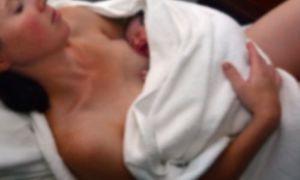Help Center
Online Resource Center for Information on Birth Injuries.

Perinatal tears (or vaginal tears) are one of the many physical hardships women often suffer during childbirth. The perineum is the small area of tissue that separates the vagina and the rectum. Perinatal tears occur when the skin and tissue in this area are torn and lacerated from overstretching during vaginal childbirth.
Perinatal or vaginal tears are extremely common because of the tremendous pressure and strain involved in pushing the baby’s head through the very small birth canal. Over 90% of first-time mothers will suffer some degree of perinatal tearing during a vaginal delivery because their perineal tissue is less flexible.
Perineal tears are classified into 4 different degrees of severity. The degrees of perinatal tearing range from very mild lacerations of the outer lining to extremely deep cuts that can impact the anal muscles and tissue.
Perinatal tears classified as first-degree are the least serious. A first-degree perinatal tear is a superficial injury in which only the outer lining is lacerated. No underlying tissue or muscles are damaged and in most cases, no stitches are required. First-degree tears will be painful for the first week or so but generally heal quickly.
Second-degree perinatal tears are more serious, and they occur when the tear goes beyond just the outer lining and into the submucosal tissue below.
Second-degree is the most common type of vaginal tearing. Second-degree perinatal tears require stitching and take about twice as long to heal compared to first-degree tears.
A perinatal tear is classified as third-degree when the tear goes even deeper into the layers of tissue around the vagina and into the muscles around the anal sphincter. Third-degree tears are fairly serious injuries and often require surgical repair as each layer of tissue must be stitched separately. The recovery from these types of tears can be very long and painful.
Fourth-degree perinatal tears are the worst type and they occur when the tearing and laceration goes so deep that it cuts into the lining of the rectum. Fourth-degree tears are rare and require major surgery to repair all the various layers of damaged tissue. Even after surgical repair, fourth-degree tears can have permanent consequences such as pelvic floor dysfunction and problems with urination.
Vaginal tears are often an unavoidable consequence of vaginal childbirth. Pushing the baby’s head out of the very narrow birth canal requires a great deal of stretching and expanding. During labor hormones in the mother’s body will help the skin around the vagina to thin out allowing it to stretch easier. In some cases, however, the skin is unable to stretch enough, and the pressure of the baby’s head pushing its way out tears through the tissue.
Perinatal tearing is very common in almost all vaginal deliveries, but there are certain factors that make perinatal tears more likely to happen. These include:
Hizkiyahu, R., et al. “Antepartum vaginal Candida colonization and the risk for obstetrical tears.” The Journal of Maternal-Fetal & Neonatal Medicine. (2020): 1-5. (This study looked at whether vaginal Candida colonization was associated with obstetrical tears. The researchers compared 102 pregnant women with Candida colonization with 102 pregnant women without. They found no differences in outcome and obstetrical tear risk. The researchers concluded that this study confirmed that Candida colonization did not increase the obstetrical tear risk.)
Jansson, M.H., et al. “Risk factors for perineal and vaginal tears in primiparous women–the prospective POPRACT-cohort study.” BMC Pregnancy and Childbirth. 20.1. (2020): 1-14. (This study looked at the high vaginal tear, second-degree perineal tear, and obstetric anal sphincter injury incidence in primiparous women. The researchers found that fetal weights that exceeded 4,000 grams, vacuum-extractions, and post-term deliveries were significant risk factors for second-degree perineal tears and obstetric anal sphincter injuries. They also found that fetal head circumferences exceeding 35 centimeters, induced labor, pelvic floor dysfunction, connective tissue deficiencies, and vacuum extractions were significant high vaginal tear risk factors. The researchers concluded that this study confirmed prior studies on obstetric anal sphincter injuries and discovered risk factors for high vaginal and second-degree perineal tears. They also concluded that additional studies should be performed to confirm these discoveries.)
McGuire, J.A., et al. “Tear propagation in vaginal tissue under inflation.” Acta Biomaterialia. (2021). (This study used rat vaginas to determine vaginal tearing’s mechanisms. The researchers reported that this novel model showed the vagina’s toughening mechanisms. They were able to measure tear geometry, strain distribution, and collagen fiber orientation.)
Sagi-Dain, L., et al. “In women with spontaneous vaginal delivery, repair of perineal tears might be easier compared to episiotomy.” International Urogynecology Journal. (2021): 1-6. (This study looked at whether suturing episiotomies was easier than spontaneous perineal tear repairs. The researchers found that episiotomy repairs were associated with adverse suturing effects. They also found that they had longer suturing durations in non-operative vaginal deliveries. The researchers concluded that suturing spontaneous vaginal tears was shorter and easier than repairing episiotomies.)
Von Theobald, P., et al. “Risk factors associated with severe perineal tears: A five-year study.” Journal of Gynecology Obstetrics and Human Reproduction 49.7 (2020): 101820. (This five-year study looked at severe perineal tears’ risk factors in both non-operative and operative vaginal deliveries. The researchers found that gestational ages over 39 weeks and birth weights over 3,500 grams were associated with severe perineal tears in non-operative vaginal deliveries without episiotomies. They also found that diabetes, gestational age, and episiotomies were risk factors for severe perineal tears in operative vaginal deliveries. The researchers concluded that severe perineal tear risk factors differed based on whether the vaginal delivery was operative or non-operative. They also concluded that this merited additional investigations regarding a mediolateral episiotomy’s protective effects against severe perineal tears in operative deliveries.)